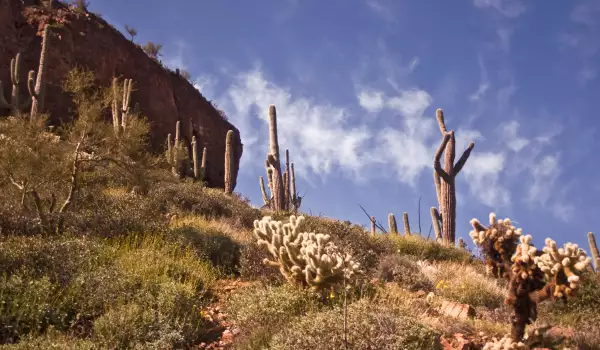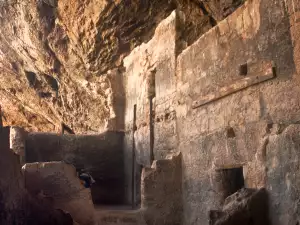Tonto National Monument

Tonto National Monument is located in Arizona, located near the northern edge of the Sonoran Desert. Salt River passes through the region and provides water throughout the year - a resource that is particularly valuable in these dry areas.
The territory of the Tonto National Monument has preserved cave dwellings that were occupied during the period from the thirteenth to the fifteenth century by the Salado culture, which developed livestock and agriculture throughout Salt River Valley. They made a living for their families by hunting as well. People of the Salado culture were skilled craftsmen, producing pottery and woolen fabrics, which were highly valued at the time. Some of the artifacts recovered by archaeologists at the surface can be seen by tourists in the museum attached to the visitor center.
Tonto National Monument is surrounded by the Tonto National Forest, where trees and mountain pines grow. In this part of the Sonora desert is also the saguaro cacti. Here blossom, throughout spring, the barrel cactus, as well as yucca and agave.

Tonto National Monument of Arizona is also home of the Arizona Walnut and Sycamore trees. The area is occupied by Africanized honey bees, often settling in one of cave dwellings, or dangerously close to it. Then dwellings need to be temporarily closed to visitors until the bees move elsewhere. Tourists climb up the special trail known as the Lower Cliff Dwelling trail, to see the ruins from a distance.
In the area there are different kinds of snakes, frogs and many different types of wildflowers. In 1883 archaeologist Adolph Bandelier was among the first who examined the cave dwellings. He claimed that this is one of the most preserved cave dwellings, which he has ever seen.
These homes were inhabited by people long ago - the first settlers inhabited the area in the first century BC until around the sixth century. Eagle Ridge villagers make a living from farming and hunting, and unlike their ancestors, also from cotton and legumes. Residents of Eagle Ridge are solid proof of how people have turned from hunters and gatherers of berries and roots into farmers.
In the sixth century people living here, suddenly left the area and it remained empty for about a hundred and fifty years. In their place came people from the valley of Salt River. They used irrigation to extract greater yields from crops planted.

These people sell their production and manufactured goods from there all the way to Colorado. During the 1100s, the population reached its economic and social peak. The population was growing despite dwindling resources. Many people left their homelands, then continued life as nomads. Many families moved to Tonto, to use the resources of the area. In 1275, thousands of people were living in the area.
In 1330, however, drastic changes occurred in the climate that led to the reduction of water resources. This is reflected in the farming, and the increased hunting of animals, as people had nothing to earn with. The killing of large numbers of animals dramatically affected the ecosystem in the region.
Competition for vital resources began to reflect badly on those living in the area. At that time, flooding was caused by the Salt River too. It destroyed farms and homes.















